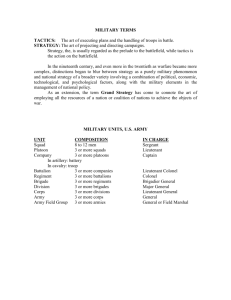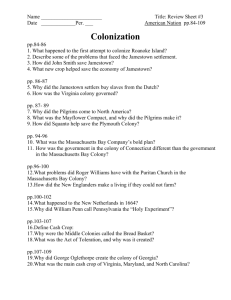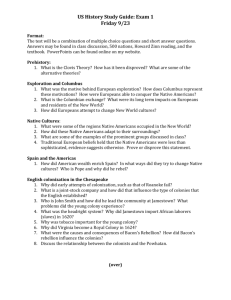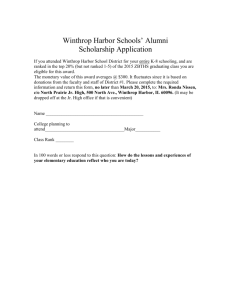The Military History of John Endecott - Endecott
advertisement
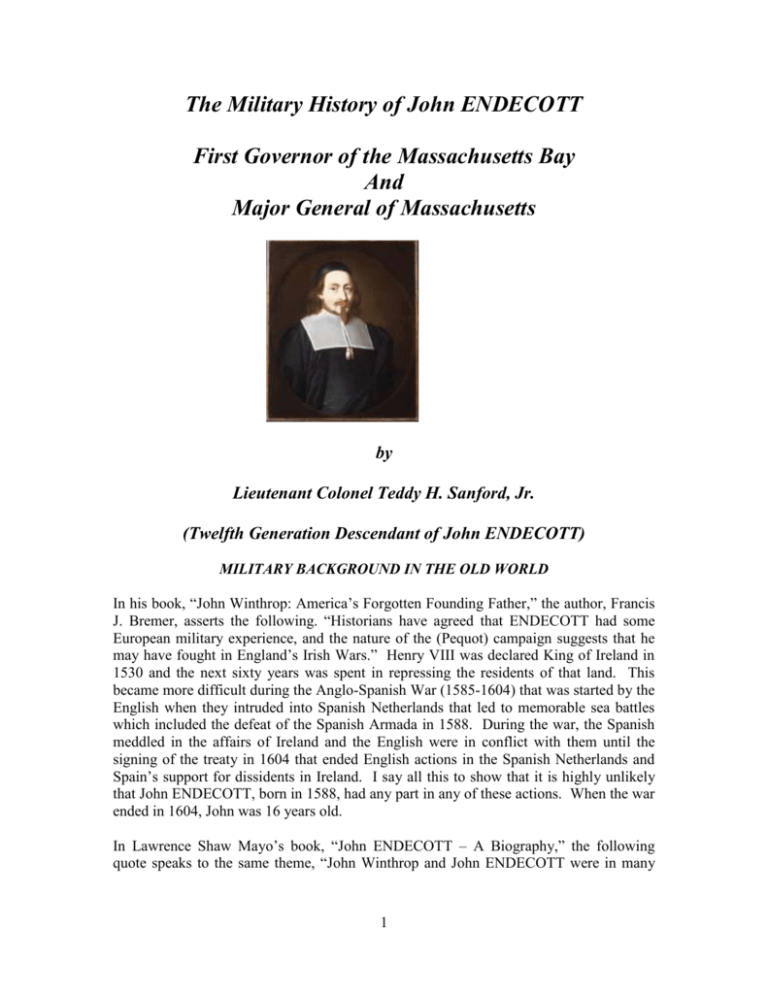
The Military History of John ENDECOTT First Governor of the Massachusetts Bay And Major General of Massachusetts by Lieutenant Colonel Teddy H. Sanford, Jr. (Twelfth Generation Descendant of John ENDECOTT) MILITARY BACKGROUND IN THE OLD WORLD In his book, “John Winthrop: America’s Forgotten Founding Father,” the author, Francis J. Bremer, asserts the following. “Historians have agreed that ENDECOTT had some European military experience, and the nature of the (Pequot) campaign suggests that he may have fought in England’s Irish Wars.” Henry VIII was declared King of Ireland in 1530 and the next sixty years was spent in repressing the residents of that land. This became more difficult during the Anglo-Spanish War (1585-1604) that was started by the English when they intruded into Spanish Netherlands that led to memorable sea battles which included the defeat of the Spanish Armada in 1588. During the war, the Spanish meddled in the affairs of Ireland and the English were in conflict with them until the signing of the treaty in 1604 that ended English actions in the Spanish Netherlands and Spain’s support for dissidents in Ireland. I say all this to show that it is highly unlikely that John ENDECOTT, born in 1588, had any part in any of these actions. When the war ended in 1604, John was 16 years old. In Lawrence Shaw Mayo’s book, “John ENDECOTT – A Biography,” the following quote speaks to the same theme, “John Winthrop and John ENDECOTT were in many 1 ways quite unlike. One was a country squire; the other was a soldier,” (Chapter X, page 104). Again, the book provides no documentary evidence of military service. The first mention of military rank was on May 28, 1629 when Captain John ENDECOTT received the Second General Letter of Instructions to ENDECOTT and His Council appointing him governor of the plantation at NAUMKEAG, later named Salem, and directed him to undertake the military organization of the trading post and settlement. Not only was he to be the leader, but arms would be provided as well. This Second General Letter suggests that ENDECOTT was made a Captain by the Council of London Planters in the Massachusetts Bay. Planning had begun earlier to draw up the list of arms and ammunition to equip 100 men including one captain; one lieutenant; two ensigns; three sergeants; three drummers; and 90 privates. Among the equipment was five pieces of ordnance to be delivered by John Humphrey to Samuel Sharpe who was to have carriages made for them. Notable equipment in a long list were 100 swords; 100 firearms (flintlocks, matchlocks, and fowling pieces), 90 bandoliers with a bullet bag; 83 pole arms (halberds, pikes, and halfpikes); sixty sets of upper body armor; 12 barrels of powder; and other equipment. (For a complete list, please see George M. BODGE’S “Soldiers of the King Phillips War,” (pages 471-472). These stores probably left with John ENDECOTT on the Abigail when it sailed from Weymouth on June 20, 1628 and arrived in the Massachusetts Bay Colony on September 6, 1628. It is also likely that John had some input into the making of the list of arms to be provided. Was he an experienced soldier? Did he have other experienced soldiers to advise him? These are questions unanswered in the record. MILITARY ACHIEVEMENT IN THE NEW WORLD When John ENDECOTT and his small group arrived in NAUMKEAG, their first task was to survive. Many were sick on the voyage and John’s wife, Ann GOVER, was among those who died the first year. As far as military preparedness, the only thing the small group accomplished was to provide local security in and around their dwellings. It was fortunate that, at this early stage, the Native American population remained passive. In fact, for the first two years of the colony, the militia was only used for defense. These conditions changed when the John Winthrop fleet arrived in 1630. Among the new colonists were two soldiers. John Underhill (1597-1672) had served as a cadet in service to Prince William, the Prince of Orange in the Netherlands (Dictionary of National Biography, Volume 58, Edited by Sidney Lee, 1899). In later years, Underhill was tried for being “— impatient of civil and ecclesiastical authority and did not easily endure command.” He was banished from the colony but was later pardoned (BODGE: “Soldiers of the King Phillips War,” pages 469-470). Eventually, he went to the Dutch settlements on the Hudson River and was given command of a company. He led a successful engagement of Dutch and English soldiers against the Indians in a night attack at the “Battle of Strickland Plain” in February of 1644 when 500-700 Indians were killed (“Ye History of Ye Town of Greenwich” by S. Mead, 1913). After this action, he settled in Flushing, Rhode Island. Daniel Patrick (1605-1643) had served as a common soldier in the Prince of Orange Guard. He was of a “proud and vicious” nature and guilty of disregarding his wife as he “followed after other women.” When threatened by the law, he fled to 2 the Dutch settlements. He had problems there as well and fled again to the house of Captain Underhill where he was overtaken by the Dutch and killed with a shot through the head after he spit on one of the pursuers (BODGE – “Soldiers of the King Phillips War,” page 472). These two men were the ones Winthrop charged to “instruct the men of the new colony in military tactics and direct any warlike operations which might be necessary in defense of the settlement.” It is my view that if John ENDECOTT had been an experienced soldier, this charge would not have been made by Winthrop. At first, Captain Underhill and Captain Patrick were in charge of the militia in all towns and they oversaw weekly training days under the direction of sergeants. This led to the first tax levied to support the officers on 28 September 1630. John Endecott and the King’s Ensign In 1634, John ENDECOTT was nominated to be one of the seven military commissioners for the colony. That year, the King demanded the Charter in an attempt to force the Puritan to celebrate the ceremonies of the Church of England. John, a staunch Puritan, who often mixed religion, soldiering, and politics together, was inflamed by the fiery eloquence of Roger Williams, and publicly cut out the Cross of St. George from the Colony banner with his sword. He stated that the cross in the banner “—savored Popery.” The colony and Governor Winthrop were not in a position to ignore the act and brought action in the General Court against john where he was admonished and denied public office for a year. He was forced to make his apologies that same day and retired from service for a year. Picture Credit: Reproduced by Permission from the Publisher, Doubleday and Company, Inc. By the winter of 1636, the militia was beginning to take shape and was reorganized into three regiments on 13 December 1636 (Massachusetts Records 1:186-7,190-1). The South Regiment was commanded by Colonel John Winthrop, Sr. with the assistance of Lieutenant Colonel Thomas Dudley. Captain John Underhill commanded the company from Boston; Lieutenant Richard Morris commanded the company from ROXBERRY; and Captain Israel Stoughton commanded the company from Dorchester. The North Regiment was commanded by Colonel John Haynes with his deputy Lieutenant Colonel Roger HARLAKENDER. There were four companies from Charlestown, Newtown, Watertown, and Concord under Captains Robert Sedgwick; George Cooke; William JENNISON; and Lieutenant Simon Willard. Colonel John ENDECOTT was in command of the East Regiment with the assistance of Lieutenant Colonel John Winthrop, Jr. Captain Nathaniel Turner commanded the company from Saugus; Captain William TRASKE commanded in Salem; Captain Daniel Denison in Ipswich; and Captain John Spencer at Newberry. 3 The Pequot War The need for the formation of the regiments had been made clear by the early actions in the Pequot Indian War that began in 1636 and lasted until 1638. This was the first major conflict between the new colonists and a Native American tribe. The killing of a trader, John Oldham, precipitated the hostilities. Since there were no large military structures in the summer of 1636, Governor Henry Vane called on John ENDECOTT that August to head a ninety man force to seek justice from the Pequot tribe. He was assisted by Captain Underhill. John and his men proceeded to Block Island where they spent two days destroying villages and claiming up to 14 Indians were killed. This number was never confirmed. Picture Credit: Reproduced by Permission from the Publisher, Doubleday and Co., Inc. The force then proceeded to SAYBROOK, a settlement at the mouth of the Connecticut River, and added to their force there before attacking a Pequot village at the mouth of the Thames River. The Indians escaped but their village and food stores were either destroyed or confiscated. With this accomplished, John took his forces back to Boston while the SAYBROOK forces under Lion Gardiner (1599-1663) were left to remove the Pequot crops. The Pequot tribe reformed and attacked and it was a near thing before the SAYBROOK militia was able to retire. John ENDECOTT played no further role in the war which ended with the Treaty of Hartford in 1638 which resulted in the remaining Pequot tribe members being dispersed among the other tribes. First Major General of Massachusetts In 1644, the militia was reorganized once again. The title of “Colonel” was dropped and the regimental commanders became “Majors”. The Chief Military Officer in the colony was given the title of “Sergeant Major General,” and Thomas Dudley became the first “Sergeant Major General of Massachusetts.” This old title was soon modified to the modern form of “Major General.” In 1645, John ENDECOTT succeeded Dudley as “Major General of Massachusetts.” He held this position from 1645 until 1649 and relinquished it to begin his third term as Governor of Massachusetts. This is all that can be reasonably said of John ENDECOTT regarding his military service. It was a mixture of command, politics, religion, and limited field service. Given his many terms as Governor of the colony, it was probably enough. 4 Bibliography 1. Bremer, Francis J. John Winthrop: America’s Forgotten Founding Father. (New York, New York: Oxford University Press, 2003). 2. Mayo, Lawrence Shaw, John Endecott, A Biography. (Cambridge, Massachusetts: Harvard University Press, 1936). 3. Young, Alexander. Chronicle of the First Planters of the Colony of Massachusetts Bay from 1623-1636. Reprinted. (Baltimore: Genealogical Publishing Company, 2004). 4. Bodge, George M. Soldiers in the King Phillips War 1891. (Leominster, Mass: Printer for the Author, 1896). 5. Shurleft, Nathaniel B. Records of the Governors and Company of the Massachusetts Bay from 1628-1641 Vol. I. (Boston: From the Press of William White, Printer to the Commonwealth, 1853). 6. Stephen, Leslie and Lee, Sidney, Editors. Dictionary of National Biography, Volume 58. (New York: MacMillan, 1899). 7. Mead, Spencer Percival. Ye History of Ye Town of Greenwich. (New York: Knickerbocker Press, 1913) The image of Governor John Endecott is the Commonwealth portrait and has been provided by Susan Greendyke Lachevre, Art Collection Manager, Massachusetts Art Commission. State House, Room 1, Boston MA. 02133. Permission to use has been granted. As always, many thanks to LTC Gordon S. Harmon for his many contributions to this article. 5
